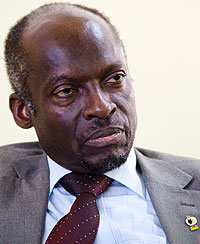STATISTICS OF the initial admissions to the University of Rwanda (UR) for the 2014/2015 academic year showed that only one third of the admitted applicants were female, which is in line with past trend.


STATISTICS OF the initial admissions to the University of Rwanda (UR) for the 2014/2015 academic year showed that only one third of the admitted applicants were female, which is in line with past trend.
This subsequently sparked a media debate on how to increase the proportion of female students in Higher Learning Institutions (HLIs). One of the popularly proposed methods was affirmative action by giving female applicants extra marks.
It is not an option UR Management is considering. Before discussing the merits and demerits of affirmative action as a solution, it is essential to critically examine data on female students’ participation in the education sector, from Primary school through to Tertiary.
According to the 2012 Education Statistics Year Book released by the Rwanda Ministry of Education in February 2013, from 2008-2012, the average female enrollment was about 50.8% in Primary schools and 50.2% in Secondary schools.
On the other hand, at the tertiary level and in the same period, the average female enrollment was 33% in Public HLIs and 53.4% in the Private HLIs. For the TVETs, the average female enrollment from 2010-2012 was about 41.8%.
The low female enrollment in the Public HLIs seems to also be the trend in some of the institutions in East Africa where the average female enrollment is about 33%. However, in South Africa about 61% of the enrollment in Public HLIs is female.
The above statistics tend to suggest the existence of a hurdle that constrains the access of female students to TVETs and Public HLIs. The obstacle cannot be their inability to qualify because from the same pool of students that completed secondary schools more female were enrolled in the Private HLIs.
Furthermore, an analysis of the 2013 S6 examination results shows that 46% of the 23958 candidates who got at least 2 principal passes, and, therefore, eligible for admission into the University, were female. Of those students who completed senior secondary school last year and were qualified to apply, only about 18962 applied for admission to UR and 30% of them were female.
It means that only 5,759 females out of the possible 11092 applied for admission to UR. The question is why did the rest (i.e. 5333) of them not apply and where are they? It is most likely that some of them will be admitted into the Private HILs. This raises a further question as to why female applicants seem to prefer Private to Public HLIs.
One might tend to argue that Private HLIs offer humanities based programmes which usually attract more female students. However, at UR currently, the College of Arts and Social Sciences (CASS) has the lowest proportion of female students (about 26%).
In conclusion, the low female enrollment at UR is a matter of concern and it needs to be addressed. Since, based on the preliminary analysis, failure to qualify does not seem to be the issue, and then the proposed affirmative action process of inflating marks or lowering admission levels will not address the problem.
In fact it will make matters worse because the under qualified female students will not perform as well and this could lead to stigmatization and stereotyping of female intellectual capacity.
There is a need for further research to understand why only few females apply for admissions to Public HLIs although many more qualify to apply.
There is also a need to investigate why more female students prefer to enroll in Private HLIs than in Public ones. The solution to the problem is more complex and may require socio-economic interventions or even review of modes of programmes deliveries at Public HLIs to allow the flexibility that might suit female students.
The writer is the Deputy Vice Chancellor, Academic Affairs and Research, at the University of Rwanda. This article is written in his personal capacity.


